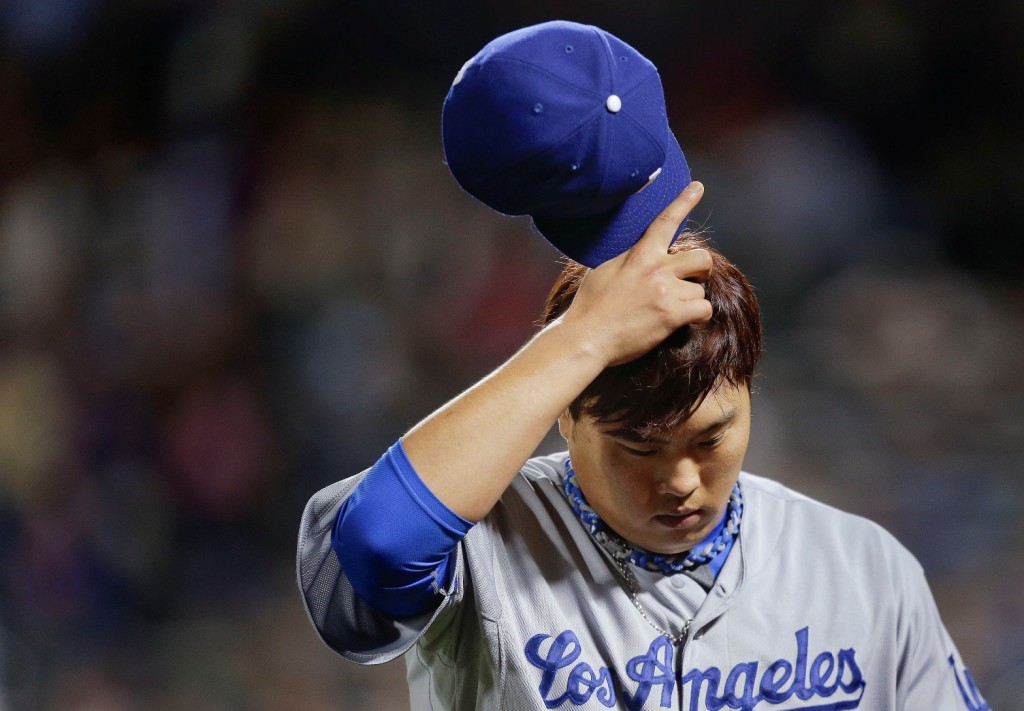- California Assembly OKs highest minimum wage in nation
- S. Korea unveils first graphic cigarette warnings
- US joins with South Korea, Japan in bid to deter North Korea
- LPGA golfer Chun In-gee finally back in action
- S. Korea won’t be top seed in final World Cup qualification round
- US men’s soccer misses 2nd straight Olympics
- US back on track in qualifying with 4-0 win over Guatemala
- High-intensity workout injuries spawn cottage industry
- CDC expands range of Zika mosquitoes into parts of Northeast
- Who knew? ‘The Walking Dead’ is helping families connect
For Dodgers’ Ryu, shoulder surgery carries financial implications
(Yonhap) — Once Ryu Hyun-jin undergoes shoulder surgery that will likely rule him out for 2015, he won’t just be missing time on the mound. The South Korean pitcher for the Los Angeles Dodgers will also take some significant financial hits off the field.
The Dodgers have announced that Ryu, 28, will undergo arthroscopic surgery in Los Angeles on Thursday, local time. Though the club didn’t immediately provide the timetable for his return, Ryu is likely done for the season.
It’d be a devastating blow for a pitcher who frequently said in the offseason that his biggest goal for 2015 was to pitch 200 innings. And it will also have a major financial impact for Ryu.
In December 2012, Ryu became the first South Korean player to make the jump from the domestic Korea Baseball Organization (KBO) to the majors, signing a six-year, US$36 million deal with the Dodgers after getting posted.
Under contract until 2018, Ryu is slated to make $4.83 million this year. In each of his next three seasons, Ryu is supposed to earn $7.83 million.
He has an opt-out clause that will allow him to declare free agency after the 2017 season if he reaches 750 innings between 2013 and 2017. He has thrown 344 innings so far. With the 2015 season out of the picture, Ryu will have to pitch more than 400 innings in 2016 and 2017 to meet that requirement.
It will be a tall order for a pitcher who hasn’t thrown 200 innings as a professional since 2007. A jackpot in the open market seems to be an increasingly distant possibility.
The shoulder operation will also add to Ryu’s injury history. As a high school phenom in 2004 in South Korea, Ryu had elbow reconstructive prcedure, known as Tommy John surgery. When his contract runs out, teams may be reluctant to shell out big bucks for a 31-year-old pitcher with a history of elbow and shoulder operations.
Also, under the terms of his contract, Ryu gets $250,000 for reaching 170 innings, 180 innings, 190 innings and 200 innings each season. There will be no such bonuses this year.
Ryu joins the ranks of other Asian-born big league pitchers who struggled with injuries in their third seasons. Hideo Nomo, the 1995 National League Rookie of the Year for the Dodgers, saw his ERA and walk rate jump in his third season, and then got traded during his fourth year. Nomo had an elbow operation after the end of his third season and it took him years to regain his effectiveness.
Daisuke Matsuzaka won 33 games in his first two seasons with the Boston Red Sox, but was limited to just 12 starts in his third season in 2009. He went from 18-3 with a 2.90 ERA in 2008 to 4-6 with a 5.76 ERA in 2009. He never again reached double figures in wins.
Yu Darvish of the Texas Rangers saw his inning totals dip from 209 2/3 in 2013, his second big league season, to just 144 1/3 last year. Darvish underwent a season-ending elbow operation in March.
Ryu joined the Dodgers having already logged nearly 1,300 innings in seven seasons in the KBO. Matsuzaka had thrown 1,402 2/3 innings in eight Nippon Professional Baseball (NPB) seasons, while Darvish had 1,268 1/3 innings there before reaching the majors.
High mileage likely had something to do with their woes, but tighter pitching schedules and extensive traveling may also have contributed to their downfall.
In the KBO and NPB, starters routinely get six days off in between appearances. Playing in those two leagues requires much less travel because each country is in one time zone.
In the majors, a five-man rotation is the norm, with the starters usually getting four days off in between games. Flying red-eye flights through time zones is also a big part of adjustments for South Korean and Japanese players.













![일본 사도광산 [서경덕 교수 제공. 재판매 및 DB 금지]](http://www.koreatimesus.com/wp-content/uploads/2024/07/PYH2024072610800050400_P4-copy-120x134.jpg)


